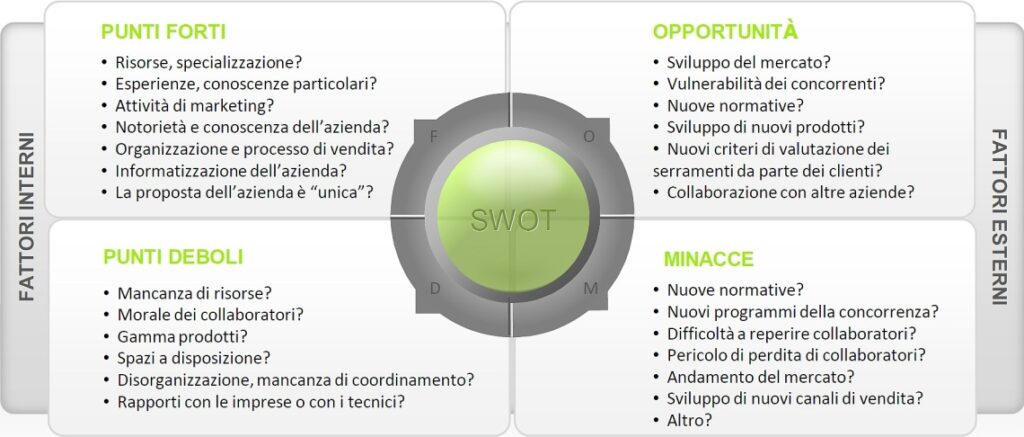Planning is an exercise that makes success more probable because it allows to single out the objectives the company wishes to achieve and to assess with greater objectivity the company’s strengths and opportunities. Nowadays it is especially important to have clear ideas about the strengths one has working in the markets of interest and to make well thought-out decisions for the future that awaits us when we get back to work again.

A good marketing plan can help make our company start up again only when in formulating it we keep a critical attitude and we work committedly, knowing that, as many surveys have proven, the companies that have a (written) plan achieve results 20 to 30% better than those of their competitors without one.A second condition is equally important: the choices must be oriented towards the consumer purchasing the doors and windows manufactured by the company.
How does one develop the marketing plan?

Writing a marketing plan needn’t be a nightmare. It is more like preparing a simple but nourishing dish consisting of six ingredients:
- Collection of information to obtain a snapshot of the situation: where are we at?
- Description of the clients (target) one would like to have. One must make a special effort in describing the clients, going into detail. Just saying: “Our clients are private citizens”, for example, does not help with the next choices. Who is our target?
- Establishing the objectives. In less than one page one must indicate the objectives the company must have. One should concentrate on key objectives and make sure to express them in realistic, pursuable and quantitative terms. In this way, in the period of time covered by the plan, it will be possible to easily assess the company’s current performance and this will be easier if the will to increase sales is expressed as follows: “Increase overall sales by 15%,and by 20% those of theEsperia 80 windows”. Where are we going?
- Development of a strategy and of the related tactics with ensuing actions planned to attain the objectives. It is a delicate phase of the plan and requires the re-examination of how and how much has been done in the past and which possible changes can be made in the near future.What must we do to reach our goals?
- Projection of sales in global terms and by product family (windows, doors, products sold, etc.). The sales should be indicated also by sales channel (direct for private clients and indirect via retailers, for example) and by geographical area (province or region…). There should also be an income projection. How much will we earn?
- Definition of the budget, or forecast of the costs that will be incurred, for each action planned. If one finds that the planned tactics are too expensive in view of the company’s resources or of the results they will bring, then the tactics as well as the objectives must be revised.How much will we spend?
The current situation
In order to sketch a picture of the current situation, there must be an initial collection of information that is internal and external to the company. Information sources canbe internal statistics or the analysis of orders, news collected by the sales staff, newspaper and trade journal articles, the Internet.

The information to be collected regards:
- sales of the company and of the market of reference. Analysing this kind of information forces one to deal with hard data and not just with opinions.Sales must be broken down by product line, sales areas, sales channels or, more simply, by client type;
- markets in which the company competes and sells. Companies manufacturing windows and doors obviously need to analyse the building construction market;
- trends.One must check the factors that could influence the market (social situation, regulations, competition, government policies, innovations and consumer behaviour) and consequently the company’s marketing choices;
- competition among different products and different manufacturers. Competitors are especially those considered an alternative to your company by the clientele.One must know all the strengths and weaknesses of one’s competitors, as well as their strategy and, when possible, the good practices they follow to be successful;
- product distribution. The real competitors of many small window and door manufacturers are the retailers and not other manufacturers. Whenever a manufacturer sees himself solely as a manufacturer, he loses something to the retailer who specialises in sales and in sales-related services.By keeping the evolution of distribution under control one can identify new market niches or areas of specialisation.

Knowledge of the company and of the market is also measured via the capacity to perform SWOT analysis,a tool that helps during strategy planning.SWOT analysis helps identify a company’s Strengths, Weaknesses, Opportunities and Threats. Strengths and weaknesses are internal factors that are the foundations of a competitive edge or that give access to competitor attacks. These factors can include corporate skills and resources available.
Opportunities and threats are external factors that are beyond the company’s control. They may include regulatory, social or demographic aspects (epidemics such as the current one, development of specific areas, population increases in specific areas) and economic aspects (income levels and/or tax benefits). One should conduct this analysis with the help of employees and also by exchanges with other non-competing sector operators.
The following picture can help with SWOT analysis because it has a check list format.

The attention must be placed on the factors – maximum 3 to 5 – that make the difference. Those are the factors that explain 70% of a company’s competitiveness or are the market situations that must be harnessed in order to guarantee company success. A list that has too many strengths compared to too few weaknesses indicates that the analysis must be redone because it is not objective and therefore too optimistic.
The 3 ‘M’s model
In the Situation Analysis phase, as well as in others, the 3 ‘M’s scheme indicates the key resources needed to implement the plan:
- the first M stands for Men. The plan must contain a section listing the skills and experience from the employees called to flank the entrepreneur in executing the plan, with the addition of new help when required;
- the second M stands for Money. Does the company have the necessary economic resources? How can it finance the plan?;
- the third M stands for Minutes, i.e. the objectives and actions listed in the plan must be time-scheduled. This means that a schedule must envisage start and end dates for the activities, but must also consider sales volumes per period of the year because this affects cashflow.
In Part 2 we will examine the description of target clients, the choice of objectives and the identification of the necessary budget.





